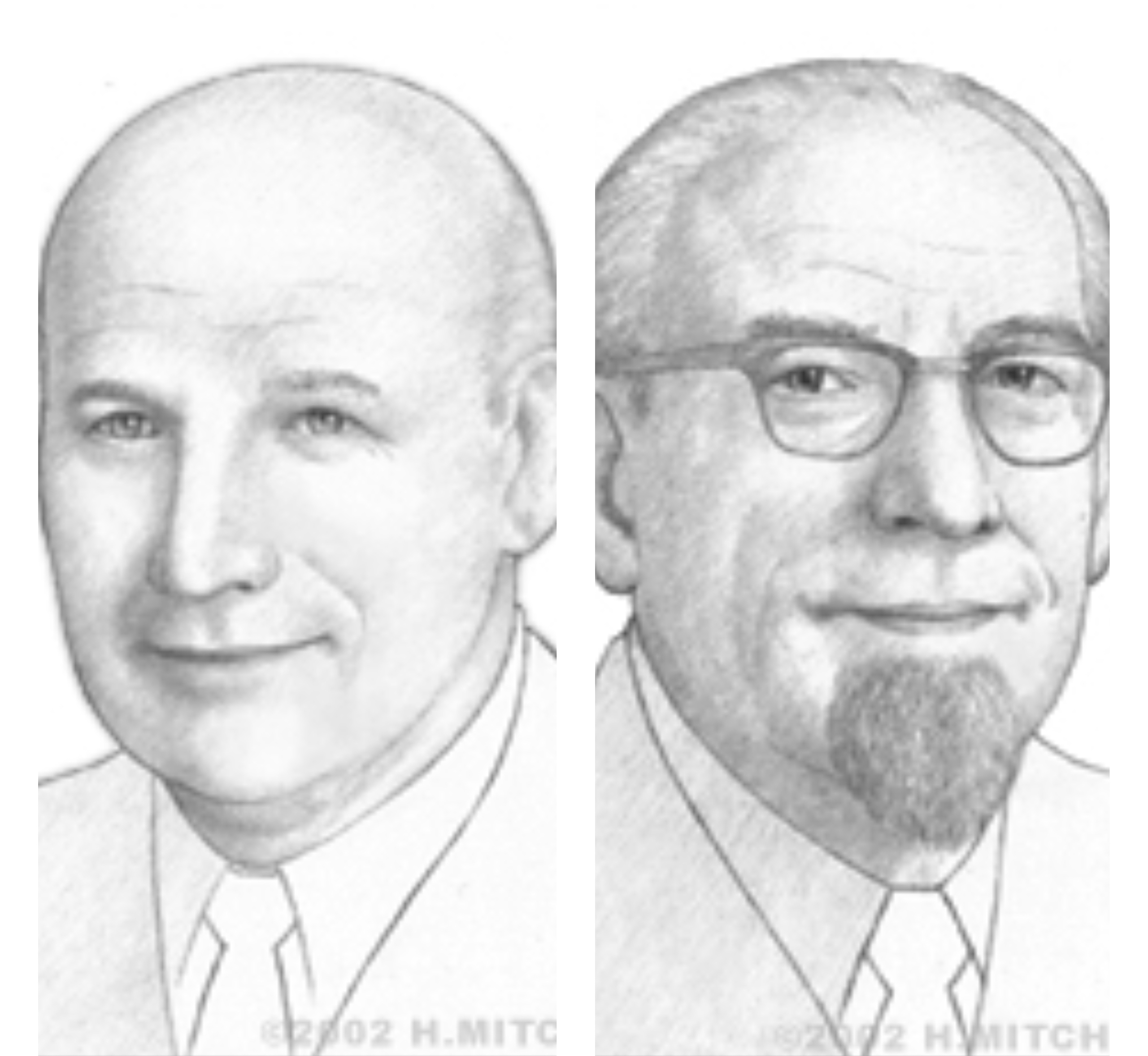J. Presper Eckert and John Mauchly
John William Mauchly and J. Presper Eckert are the scientists credited with the invention of the Electronic Numerical Integrator and Computer (ENIAC), the first general-purpose electronic digital computer completed in 1946.
Mauchly was born August 30, 1907 in Cincinnati, Ohio. His father was a physicist at the Carnegie Institute of Washington, D.C., and likely influenced young Mauchly to pursue science. Mauchly earned the Engineering Scholarship of the State of Maryland, which enabled him to enroll at Johns Hopkins University in the fall of 1925 as an undergraduate in the electrical engineering program. In 1927 he enrolled in the physics program at John Hopkins and went on to complete a Ph.D. in 1932. Soon after he became a professor of physics at Ursinus College near Philadelphia.
J. Presper Eckert Jr. was born April 9, 1919 in Philadelphia. In 1937 he entered the Moore School of Electrical Engineering at the University of Pennsylvania and graduated in 1941. Afterwards he was given a post as an instructor at the Moore School where Mauchly had recently become a student in a new program designed to educate students on defense technology. Eckert became one of Mauchly’s teachers.
Mauchly became interested in electronic calculating machines and at the Moore School he gained a better understanding of electronic engineering and the mathematics of ballistics computations. He and Eckert discussed the possibility of building a large electronic computer. In 1942 Mauchly drafted a memo outlining the first large-scale digital electronic computer designed for general numerical computations. An official proposal was submitted in April of 1943, and the U.S. Army provided a grant for “Project PX,” which Mauchly and Eckert together undertook.
The ENIAC was born out of a combination of many different design ideas. Mauchly, who was responsible for much of the overall design, is said to have been influenced by the work of Iowa State College professor John V. Atanasoff, who had designed and built an electronic computing device between 1937 and 1942 with a graduate student, Clifford Berry. Eckert was the main project engineer for ENIAC. He overcame many difficult technical challenges before he succeeded.
Additionally, six women contributed to the success of ENIAC through their work as programmers. Their names were Frances Bilas, Jean Jennings, Ruth Lichterman, Kay McNulty, Betty Snyder and Marlyn Wescoff. Unknown to many, these six women wrote and tested the programs for the ENIAC and without their work, the project may not have been completed. During World War II, the U.S. Government asked women to fill-in with positions typically given to men. This is how the women were hired by the U.S. military to hand-draw and calculate the path of ballistics. The team wasn’t given much instruction or guidance but after months of work, they succeeded in programming the huge machine. The hour-long calculations they performed by hand would only take a computer mere seconds today.
The ENIAC was unveiled to the public on February 14, 1946. Though it had been funded as a technology that might help the war effort, the war was over by that time. ENIAC was nevertheless employed by the military to do calculations for the design of a hydrogen bomb, weather prediction, cosmic-ray studies, thermal ignition, random-number studies and wind-tunnel design. It was built from 17,468 electronic vacuum tubes and weighed more than 60,000 lbs.—at the time it was the largest single electronic apparatus in the world. The system could perform 5,000 additions and 300 multiplications per second—slow by today's standards but 1,000 times faster than any existing machines. It was also highly reliable. It marked the beginning of a long road of computer technology development.
Mauchly and Eckert resigned from the Moore School shortly after the public announcement of the ENIAC and formed the Electronic Controls Company. Eckert assumed the task of designing a new computer system, while Mauchly conducted research into the possible uses for electronic computers. They began designing an electronic computing system for their first client—the U.S. Census Bureau—and became the Eckert-Mauchly Computer Corporation in December, 1948. In 1949, their company launched the BINAC (BINary Automatic) computer, which used magnetic tape to store data. They sold their company to Remington Rand in February of 1950, and it became the Univac Division of Remington Rand. Their research resulted in the UNIVAC (UNIVersal Automatic Computer). The first UNIVAC computer was delivered to the Census Bureau in June 1951.
In 1955, Remington Rand merged with the Sperry Corporation and formed Sperry-Rand. Eckert remained with the company as an executive and continued with the company as it later merged with the Burroughs Corporation to become Unisys. He retired in 1989. Meanwhile, Mauchly left Rand Computing in 1959 to set up his own consulting firm, Mauchly Associates. Later in the 1960s he formed another consulting company called Dynatrend.
Eckert and Mauchly were recognized with numerous honors and awards for their work, having both received the U.S. National Medal of Science in 1969 and the IEEE Computer Society Pioneer Award in 1980. Mauchly died in 1980. Eckert died in 1995.


